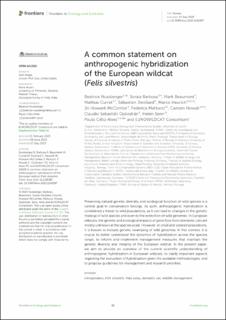| dc.contributor.author | Nussberger, Beatrice | |
| dc.contributor.author | Barbosa, Soraia | |
| dc.contributor.author | Beaumont, Mark | |
| dc.contributor.author | Currat, Mathias | |
| dc.contributor.author | Devillard, Sébastien | |
| dc.contributor.author | Heurich, Marco Dietmar | |
| dc.contributor.author | Howard-McCombe, Jo | |
| dc.contributor.author | Mattucci, Federica | |
| dc.contributor.author | Nowak, Carsten | |
| dc.contributor.author | Quilodrán, Claudio Sebastián | |
| dc.contributor.author | Senn, Helen | |
| dc.contributor.author | Alves, Paulo Célio | |
| dc.contributor.author | Consortium, EUROWILDCAT | |
| dc.coverage.spatial | Europe | en_US |
| dc.date.accessioned | 2023-10-05T08:41:12Z | |
| dc.date.available | 2023-10-05T08:41:12Z | |
| dc.date.created | 2023-09-05T09:52:41Z | |
| dc.date.issued | 2023 | |
| dc.identifier.citation | Frontiers in Ecology and Evolution. 2023, 11 . | en_US |
| dc.identifier.issn | 2296-701X | |
| dc.identifier.uri | https://hdl.handle.net/11250/3094383 | |
| dc.description.abstract | Preserving natural genetic diversity and ecological function of wild species is a central goal in conservation biology. As such, anthropogenic hybridization is considered a threat to wild populations, as it can lead to changes in the genetic makeup of wild species and even to the extinction of wild genomes. In European
wildcats, the genetic and ecological impacts of gene flow from domestic cats are mostly unknown at the species scale. However, in small and isolated populations, it is known to include genetic swamping of wild genomes. In this context, it is crucial to better understand the dynamics of hybridization across the species
range, to inform and implement management measures that maintain the genetic diversity and integrity of the European wildcat. In the present paper, we aim to provide an overview of the current scientific understanding of anthropogenic hybridization in European wildcats, to clarify important aspects regarding the evaluation of hybridization given the available methodologies, and to propose guidelines for management and research priorities. | en_US |
| dc.language.iso | eng | en_US |
| dc.rights | Navngivelse 4.0 Internasjonal | * |
| dc.rights.uri | http://creativecommons.org/licenses/by/4.0/deed.no | * |
| dc.subject | introgression | en_US |
| dc.subject | Felis silvestris | en_US |
| dc.subject | Felis catus | en_US |
| dc.subject | domestic cat | en_US |
| dc.subject | wildlife management | en_US |
| dc.title | A common statement on anthropogenic hybridization of the European wildcat (Felis silvestris) | en_US |
| dc.type | Peer reviewed | en_US |
| dc.type | Journal article | en_US |
| dc.description.version | publishedVersion | en_US |
| dc.rights.holder | © 2023 Nussberger, Barbosa, Beaumont, Currat, Devillard, Heurich, Howard-McCombe, Mattucci, Nowak, Quilodra´n, Senn, Alves and EUROWILDCAT Consortium. | en_US |
| dc.subject.nsi | VDP::Matematikk og Naturvitenskap: 400::Zoologiske og botaniske fag: 480 | en_US |
| dc.source.pagenumber | 10 | en_US |
| dc.source.volume | 11 | en_US |
| dc.source.journal | Frontiers in Ecology and Evolution | en_US |
| dc.identifier.doi | 10.3389/fevo.2023.1156387 | |
| dc.identifier.cristin | 2172364 | |
| cristin.ispublished | true | |
| cristin.fulltext | original | |
| cristin.qualitycode | 1 | |

